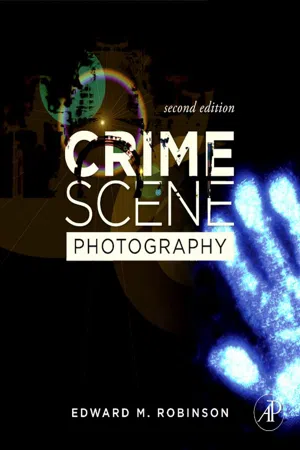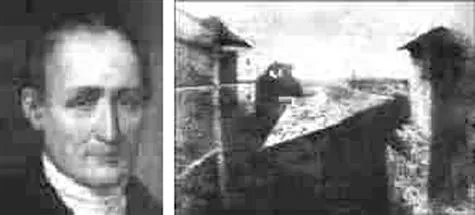My Inspiration
A common misconception is that the history of our profession is useful only to historians, teachers, students, and trivia buffs. This misconception is re-enforced by the daily pressures of the workload that sometimes has to be accomplished with inadequate staff, outdated equipment, limited funding, lack of recognition of photography as a profession, and limited training.
Several years ago, two things prompted me to put together a presentation on the history of forensic photo-graphy that I have presented at several International Association for Identification (IAI) conferences, which, in turn, evolved into this chapter. First, it became apparent this was a weak area for applicants taking the written component of the IAI Forensic Photography Certification Test. Second was the following comment that Ron Smith (retired forensic scientist and President of Ron Smith and Associates) made to me: “If you do not know the history of your profession, you are doomed to repeat its mistakes.”
As I began putting this presentation together, I soon learned that I was gaining a better insight into how the evolution from film to digital photography was changing how I do my own job, just as previous evolutionary changes in photographic technology had affected my predecessors. One pattern that I observed was that the profits in the consumer photographic market were a significant factor in the survival of a technology. As a result, when my laboratory director asked me what signs he could look for to determine when we would have to convert from film to digital, I told him the following: When you go into the local discount stores and see a dramatic reduction in film for sale to consumers, you better have the funding to convert to digital photography, and when there is no film for sale for consumers, you need to have already completed the conversion. It also made me more aware that the students in evidence technician class had to learn the same basic photographic skills with their digital cameras that I learned in the late 1970s with film-based cameras.
The Practical Value
I hope that this background will help to explain why a knowledge of the history of forensic imaging can be useful in several practical ways to anyone working in any capacity in forensic/law enforcement imaging. First, you will have the knowledge needed to refute a mistaken argument that a procedure or equipment that you use is new and novel and therefore subject to a Frye Hearing to determine admissibility. Just because it is new and novel to a defense lawyer or an individual forensic photographer does not necessary mean that it is new and novel to the forensic science community as a whole. Second, if you are going to be taking a certification test, most written certification tests include questions about the history of your profession. Third, it can help you to anticipate the likely impact and how to adapt to changes or evolution in technology. Fourth, this knowledge can help you to be better prepared to advise lawyers, managers, and others on forensic imaging issues. Fifth, keep in mind that the law enforcement market is a relatively small percentage of the overall still photography market as compared to commercial photography, the consumer market, the newspaper and magazine publishing industry, portrait/wedding studios, and mini-labs. From this perspective, it makes sense to keep up to date with what happens at the Photo Marketing Association (PMA) imaging trade show, where most of the new imaging products are announced, except for specialized equipment used only by law enforcement or other small niche markets.
The important part is that as you read through the following history, you should also be looking for patterns in the evolution of the technology and the markets for this technology. In the early days of the wet plate, the market for photographic equipment and supplies was limited to mainly professionals. There is a valid argument that Kodak changed all that when it marketed roll film cameras to the general public and provided the processing and printing. In today’s digital photography world, there are three markets: amateur or consumer, prosumer, and professional.
So much for the overview of the framework; now we move on to the main course, the history of forensic imaging.
The History
The history of forensic imaging begins with the camera obscura, the first pinhole camera. Although there may be a conflict among authors as to who is the first to describe the camera obscura, it is most likely the Arab scholar Hassan bin al Haitham who wrote about it in 1038 (Davis, 1995, p. 2; Frizot, 1998, p. 18). It is common knowledge that these early pinhole cameras were used by scientists to observe the sun and by artists to make sketches. Two others who are credited by some authors as the first to describe the camera obscura are Roger Bacon in 1267 and Leonardo da Vinci in 1490 (Davis, 1995, p. 2; Frizot, 1998, p. 17).
In reference to the early history of imaging, there are two potential reasons for differences in the date that an author lists for a specific historical event. First, each event has a possibility of four dates associated with it: when the research began, when the research results were completed, when the results were patented, and when the results of the research were first published or publicly announced.
There were three more evolutions in the design of the camera obscura that were necessary before it would have all the basic functional parts of early photographic cameras (see Figure 1.1). In 1550, Girolamo Cardano added a lens to the design of the camera obscura. It is reported that he used the word “lens” because the color of the glass lens reminded him of brown lentils that were used in Italian soup (Hedgecoe, 1980, p. 18). The second evolution, the addition of lenses and curved mirrors to produce an upright image, was accomplished in 1558 by Giovanni Battista della Porta (Davis, 1995, p. 2). However, this was not published until 1588 (Frizot, 1998, p. 18). The third evolution, the invention of a diaphragm, was believed to have been made by Daniele Barbaro in 1568 (Hedgecoe, 1980, p. 18).
Figure 1.1 This is an example of an 1840’s portable camera obscura with an adjustable diaphragm.
Photograph Courtesy of George Eastman House. © George Eastman House.
The early discoveries that ultimately led to the development of flexible silver halide-based film were also progressing slowly. In 1614, Angelo Sala observed that sunlight turned silver nitrate black. However, he did not know why, and there was no record of him recognizing the significance of this observation (Davis, 1995, p. 3). Later in 1725, Johann Heinrich Schulze proved that some silver salts were darkened by exposure to light (Davis, 1995, p. 3) (1727 according to Hedgecoe, 1980, p. 20; Frizot, 1998, p. 18). In 1737, Jean Hellot was reported to have used a photographic process to make secret writings visible by exposure to light. Hellot may have been the first one to use the word “photography,” which means writing with light (Hedgecoe, 1980, p. 20). In 1777, Carl Wilhelm Scheele discovered that silver chloride was reduced to blackened silver by exposure to light and that ammonia dissolved the silver chloride without affecting the blackened silver. However, there was no recording of Scheele’s trying to use this discovery to record photographic images (Davis, 1995, p. 3; Frizot, 1998, p. 19). The first known attempt by Thomas Wedgwood to use a photographic process to take a photograph with a camera obscura occurred in 1795. The attempt failed due to a combination of underexposure and Wedgwood’s inability to fix the image (Davis, 1995, p. 4; Hedgecoe, 1980, p. 20).
In 1800, Sir William Herschel made a discovery that would later be extremely important to law enforcement photographers. Herschel discovered the invisible infrared region by a simple experiment. He used a beam splitter to split out a white light source into individual colors when he placed a thermometer next to the red end where there was no visible color of light. This is how he discovered the infrared region of the electro-magnetic spectrum (Scott, 1969, Vol. 2, p. 79).
In 1816, Joseph Niépce began his photography experiments (Davis, 1995, p. 4; Newhall, 1964, pp. 13 and 32; Frizot, 1998, p. 19). In 1819, while Niépce was conducting his experiments, John Herschel discovered that hydrosulfite of soda dissolves silver salts (Newhall, 1964, pp. 13 and 32; and Frizot, 1998, p. 19). This was the missing link needed to fix a developed photographic image. However, it was not until several years later in 1826 when Niépce successfully made the first known photograph (see Figure 1.2). For this reason, he has been credited as being the inventor of photography (Davis, 1995, p. 4; Newhall, 1964, pp. 20–21; Frizot, 1998, p. 19).
Figure 1.2 On the left is a photograph of Joseph Niépce. On the right is the first photograph that he took in 1826.
© Brian Ratty, Photo Seminars.
It was also about this time that the first discovery critical to the development of motion pictures and video recording was made. In 1824, Peter Mark Roget wrote a paper on the persistence of vision, which was credited with leading to the following inventions that preceded motion pictures and video: Ayrton’s thaumatrope, Stampfer’s stroboscope, Faraday’s Wheel, and the flip book (Cheshire, 1979, p. 18).
There is no known record of Niépce’s technology being commercially successful. However, in 1829 Louis Daguerre formed a partnership with Joseph Niépce and, after Joseph’s death, with Isidore Niépce (Frizot, 1998, p. 21). In 1839, Daguerre’s invention, the daguerreotype, was announced by Arago. The daguerreotype used a silver nitrite light-sensitive emulsion that was developed with mercury vapor and fixed with a strong salt solution to produce a positive photographic image (Davis, 1995, p. 5). The daguerreotype was the first commercially successful photographic process. Later in this chapter, three photographic processes that replaced the daguerreotype will be discussed. In addition to their historical value, these processes are important for the modern forensic photographer because they show how the past market trends have influenced the adoption of new photographic technology. Understanding this recurring pattern may help a forensic photographer to better understand how the photographic market is likely to affect what technology will be available within the next 2 to 5 years, especially when planning for future photographic capital equipment budgets.
Before the announcement of the daguerreotype, in 1835 Fox Talbot is reported to have produced a photographic negative (Hedgecoe, 1980, p. 22). This was followed in 1839 by Sir John Frederick William Herschel’s discovery of hyposulphite of soda for fixing photographic images. Therefore, he was credited with developing hypo for fixing photographic images. Further, Herschel was also credited with coining the term “photography” (Davis, 1995, pp. 6–7; Hedgecoe, 1980, p. 20; further, according to Hedgecoe, it was Jean Hellot, who earlier used a photographic process to make secret writings visible by exposure to light, who coined the word “photography,” which means “writing with light.”). Also in 1839, William Henry Fox Talbot invented the calotype, which was a silver chloride-coated light-sensitive paper that was fixed with strong salt solution (Davis, 1995, pp. 5–6; Hedgecoe, 1980, p. 22). The calotype also appears to have been a commercially successful photographic process. The calotype was later patented by Talbot in 1841 (Hedgecoe, 1980, pp. 22–23). In my research into the history of forensic photography, I noted several conflicting dates related to several photograph...


